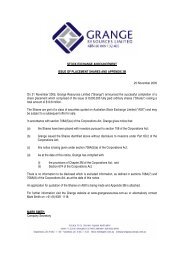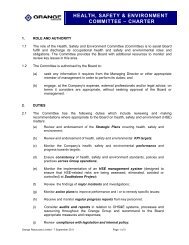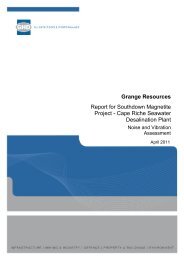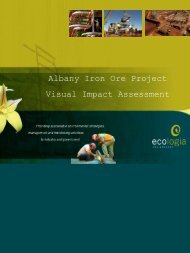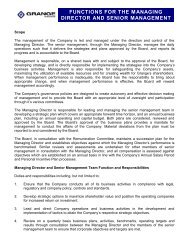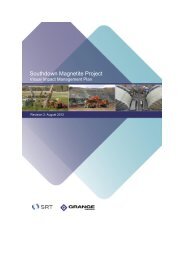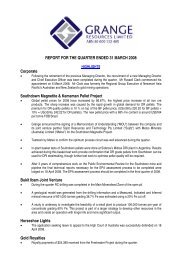Appendix A - Flora and Fauna Survey - Grange Resources
Appendix A - Flora and Fauna Survey - Grange Resources
Appendix A - Flora and Fauna Survey - Grange Resources
Create successful ePaper yourself
Turn your PDF publications into a flip-book with our unique Google optimized e-Paper software.
Levels of weed encroachment were varied across the Study Area <strong>and</strong> showed a strong correlation with<br />
the vegetation condition. Agricultural l<strong>and</strong> or areas of high disturbance within the Study Area were<br />
dominated by weed <strong>and</strong> pastoral species, while less disturbed areas showed a much lower to nonexistent<br />
level of weed encroachment.<br />
4.2 <strong>Flora</strong><br />
Some vegetation types within the Study Area have high species diversity. A total of 339 taxa from 53<br />
families was recorded during the survey. As the pipeline corridor traverses a range of vegetation types<br />
towards the coast, there is a range of flora species representing these types. Three collections could only<br />
be identified to family level (Poaceae, Restionaceae <strong>and</strong> Cyperaceae), 38 collections could only be<br />
identified to genera level <strong>and</strong> six collections could not be positively identified to species level due to lack<br />
of flowering parts or fruiting bodies. Many of these species are in the Poacaeae <strong>and</strong> Restionaceae<br />
genera, which are difficult to identify without flowering parts.<br />
Dominant families recorded included:<br />
� Protecaeae 48 taxa;<br />
� Fabaceae 46 taxa;<br />
� Myrtaceae 45 taxa; <strong>and</strong><br />
� Ericaceae 19 taxa.<br />
A full list of flora species present in the Study Area is provided in <strong>Appendix</strong> C.<br />
4.2.1 Significant <strong>Flora</strong><br />
No Declared Rare species as listed by the DEC or species of national conservation significance listed<br />
under the EPBC Act were identified within the Study Area. Three species of DRF are known to occur in<br />
the vicinity of the pipeline route. They are discussed below.<br />
Banksia verticillata – Previously recorded in the Cape Riche area within a few hundred metres of the<br />
pipeline route. This species is easily visible when not in flower <strong>and</strong> was not recorded.<br />
Myoporum cordifolium – Previously recorded in the vicinity of Gnowellen Road. This species flowers<br />
between July <strong>and</strong> November, but is relatively difficult to see in thick vegetation. Not recorded. The<br />
pipeline location is primarily in cleared farml<strong>and</strong> or firebreaks within its known vicinity <strong>and</strong> habitat type.<br />
Commersonia sp. Mt Groper – Previously recorded in the vicinity of the minesite <strong>and</strong> within 1 km of the<br />
pipeline route. This is a distinctive species present in winter wet areas. It was not recorded during the<br />
survey.<br />
Of the 53 significant plant species (DRF or Priority) identified as potentially occurring within the study<br />
area, 21 of these were considered unlikely, 12 as possible <strong>and</strong> 20 as likely to occur (Table 6, <strong>Appendix</strong><br />
C).<br />
Four species of Priority flora species as listed by the DEC were recorded from the Study Area. The<br />
location of the priority flora recorded during this survey, <strong>and</strong> those previously recorded in the area (DEC<br />
Database records) is provided in Figure 4, <strong>Appendix</strong> A.<br />
A targeted conservation significant flora survey will be undertaken in the 2011 Spring season. This<br />
survey will target previous known conservation significant flora sites (to establish population numbers)<br />
<strong>and</strong> other appropriate habitats (vegetation, soil type) within the Project footprint. In addition, as 17 of the<br />
16



